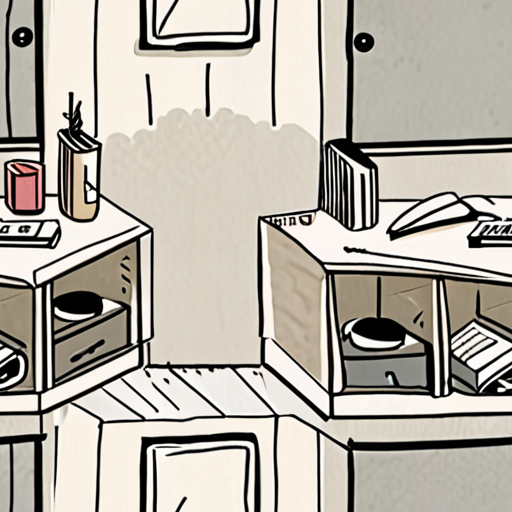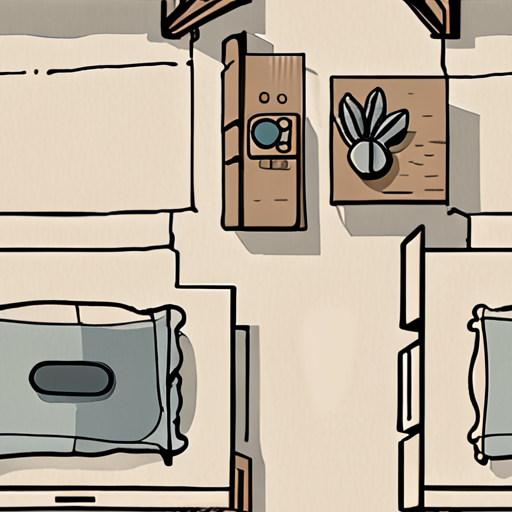Living in a small space can be challenging, especially when it comes to keeping everything organized and clutter-free. With limited square footage, it’s easy to let messes pile up and make your living situation feel overwhelming. However, there are many effective strategies for organizing small spaces, from decluttering and maximizing storage to utilizing vertical space and designing efficient layouts.

Organizing a Small Room with Too Much Stuff
We’ve all been there – staring at a cluttered room filled with too many belongings, wondering how we’ll ever get everything sorted out.
- Purge Unwanted Items: Start by going through every item in the room and deciding whether it’s something you truly need or want. Be ruthless – if you haven’t used it in the past year, it’s probably safe to let it go.
- Sort and Categorize: Once you’ve purged your unwanted items, sort what’s left into categories (e.g., clothes, books, kitchen gadgets). This will make it easier to find a place for everything.
- Assign a Home: Designate a specific spot for each category of items. For example, set up a bookshelf for your favorite novels or a storage bin for your kitchen utensils.
- Utilize Vertical Space: Make the most of your walls by installing shelves, hooks, or a pegboard. This will help keep floors and surfaces clear and create a sense of openness.
- Invest in Multi-Functional Furniture: Choose furniture pieces that serve multiple purposes, such as a storage ottoman or a desk with built-in shelving.
- Maximize Corner Spaces: Use corner carousels, baskets, or shelves to make the most of these often-wasted areas.
- Keep Frequently Used Items Accessible: Store frequently used items in easy-to-reach locations, such as a nearby drawer or shelf.
- Label and Sign: Label each storage container or shelf so you can easily identify what’s inside. Consider adding signs to highlight specific areas, like a “clothing station” or “book nook.”
- Regular Maintenance: Set aside time each week to maintain your newly organized space. Go through each area, putting away items that are out of place and tidying up any clutter.
By implementing these strategies, you’ll be able to create a peaceful and functional space that reflects your personal style.
Tips for Maximizing Storage
- Use Stackable Containers: Invest in stackable bins and boxes to store items like linens, toys, or cleaning supplies.
- Choose Compact Furniture: Opt for compact furniture pieces, such as a fold-down table or a nesting chair, to save floor space.
- Install Shelves and Hooks: Add shelves and hooks to walls and doors to maximize vertical space and keep items off the floor.
- Utilize Under-Bed Storage: Use bed risers or under-bed storage containers to stash items like out-of-season clothing or luggage.
- Consider a Closet Organizer System: Invest in a custom closet organizer system to optimize your closet space and keep clothes, shoes, and accessories neatly stored.
Additional Resources
For more tips on organizing small rooms and maximizing storage, check out our articles on Small Space Storage Ideas and Closet Organization Systems .
Organizing in Small Spaces
We understand that living in a small house can be challenging, especially when it comes to organizing your belongings.
- Start by decluttering your space and getting rid of items you no longer need or use.
- Invest in multi-functional furniture pieces that serve more than one purpose, such as a storage ottoman or a desk with built-in shelving.
- Utilize vertical space by installing shelves, hooks, or a pegboard on walls and ceilings.
- Consider using under-bed storage containers or bins to keep items like linens, out-of-season clothes, or luggage organized and out of sight.
- Make the most of corners by using corner shelves, baskets, or carousels to store items like books, kitchen utensils, or cleaning supplies.
- Keep frequently used items accessible by storing them in easy-to-reach locations, such as a countertop or a low shelf.
- Label and categorize stored items to help you quickly find what you need and maintain a sense of order.
- Implement a “one in, one out” policy to prevent clutter from building up again in the future.
- Take advantage of hidden storage opportunities, such as behind doors or under stairs, by using sliding panels, fold-down tables, or storage cubes.
- Don’t forget to optimize your closet space by using double rods, shoe organizers, or stackable shelves to maximize storage capacity.
- Finally, establish habits and routines to maintain your newly organized space, such as setting aside time each week to tidy up and putting things back in their designated place.
By implementing these strategies, you’ll be able to create a more organized and functional living space, even in a small house.

Decluttering Without Storage: A Step-by-Step Guide
We understand that having no storage can be a significant challenge when trying to declutter your home.
- Rearrange Furniture to Create More Space
- Utilize Vertical Space with Shelves and Hooks
- Invest in Multi-Functional Furniture Pieces
- Consider Renting a Storage Unit Temporarily
- Purge Unnecessary Items and Donate or Sell Them
Zone Organization
Divide larger rooms into separate zones, each with its own purpose, to maximize space and functionality.
- Designate a Zone for Sleeping, Working, or Relaxation
- Use Room Dividers or Curtains to Separate Zones
- Label Each Zone to Maintain Clarity and Organization
Additional Tips
Implement these additional strategies to optimize your decluttering process:
- Store Seasonal Items Off-Site
- Use Under-Bed Storage Containers
- Maximize Closet Space with Double Rods and Shelves
- Keep Frequently Used Items Accessible
By implementing these steps and strategies, you’ll be able to effectively declutter your home without relying on built-in storage solutions.

Organizing Your Room with Little Space
When it comes to organizing a small room with limited space, every inch counts.
- Start by decluttering and getting rid of items you no longer need or use.
- Invest in multi-functional furniture pieces, such as a storage ottoman or a desk with built-in shelving.
- Utilize vertical space by installing shelves or wall-mounted cabinets to store books, decor, or other belongings.
- Consider using under-bed storage bins or drawers to keep offseason clothing, shoes, or linens out of sight.
- Make the most of corners with corner shelves or baskets to store small items.
- Keep frequently used items in easy-to-reach locations, and store less frequently used items towards the back or on higher shelves.
- Label storage containers and shelves to help maintain organization and make it easier to find what you need.
- Implement a “one in, one out” policy to prevent clutter from building up again.
- Consider investing in a storage bed frame or a Murphy bed to maximize floor space.
- Don’t forget to leave some empty space in your room to create a sense of calm and visual balance.
Maximizing Vertical Space
By utilizing the height of your room, you can create the illusion of more space and increase storage capacity.
- Install shelves or wall-mounted cabinets to store books, decor, or other belongings.
- Use over-the-door storage racks in closets or rooms to hang jackets, bags, or accessories.
- Consider using a pegboard or a slatwall to hang tools, accessories, or other items.
- Utilize the space above your door with a shelf or a storage unit.
Under-Bed Storage
Under-bed storage is a great way to keep offseason clothing, shoes, or linens out of sight and free up floor space.
- Use bins or drawers specifically designed for under-bed storage.
- Choose bins or drawers with wheels or casters to make it easy to move them around.
- Consider using stackable bins or drawers to maximize storage capacity.
- Label your under-bed storage containers to help you quickly find what you need.
Additional Tips
To maintain a clutter-free and organized room, remember to:
- Purge regularly to get rid of items you no longer need or use.
- Establish a maintenance routine to keep your space tidy.
- Involve family members or roommates in the organization process to ensure everyone is on board.
- Be patient and flexible – organizing a small room takes time and effort!
Make a Small Room Not Look Cluttered
As a homeowner, you want your living space to feel cozy and inviting, but clutter can quickly take over a small room, making it feel cramped and overwhelming.
- Declutter Before Decorating
- Purge Unnecessary Items
- Optimize Storage
- Choose Multi-Functional Furniture
- Utilize Vertical Space
- Consider a Neutral Color Scheme
- Add Mirrors Wisely
- Keep it Simple with Patterns
- Lighting Makes a Difference
- Don’t Forget About Texture
Before you start decorating, take the time to declutter your small room. Get rid of items you no longer need or use, and organize what’s left into categories like clothes, books, and papers.
Be ruthless when it comes to getting rid of unnecessary items. Consider donating gently used items or selling them online. Remember, less is often more when it comes to small rooms.
Invest in storage solutions that fit your needs, such as shelves, baskets, or drawers. Label each container so you can easily find what you need.
Select furniture pieces that serve multiple purposes, like a storage ottoman or a desk with built-in shelving.
Maximize your walls by using wall-mounted shelves, hooks, or storage units. This will keep floors and surfaces clear and create a sense of openness.
A neutral color scheme can make a small room appear larger. Choose light colors for walls, floors, and furniture to create a sense of continuity.
Mirrors can create the illusion of a larger space by reflecting light and images. Place mirrors opposite windows to reflect natural light and make the room feel brighter.
When it comes to patterns, keep it simple. A busy pattern can overwhelm a small room, so opt for subtle textures and patterns instead.
Proper lighting can greatly impact the ambiance of a small room. Use a combination of overhead lighting, table lamps, and floor lamps to create a warm and inviting atmosphere.
Varying textures can add depth and interest to a small room. Mix smooth surfaces with rough textures, like wood or woven fibers, to create visual interest.

Rearranging a Small Room
We understand that having a small room can be challenging, but there are ways to optimize the space and make it feel larger.
-
Assess Your Space
Start by taking stock of what you have in your room. Measure the dimensions, note the location of windows and doors, and identify any architectural features that could impact your layout.
-
Prioritize Functionality
Determine how you want to use your room. Will it be a bedroom, home office, or multipurpose space? This will help you decide which furniture pieces to keep and which to discard.
-
Optimize Furniture Placement
Choose multi-functional furniture that serves more than one purpose, such as a storage bed or a desk with built-in shelving. Consider vertical storage options like floor-to-ceiling bookshelves or storage units.
-
Maximize Natural Light
Mirrors can create the illusion of a larger space by reflecting natural light. Place mirrors opposite windows to bounce sunlight deeper into the room.
-
Minimize Clutter
A clutter-free space appears larger and more inviting. Invest in storage solutions like baskets, bins, or drawers to keep belongings organized and out of sight.
-
Consider Multifunctional Decor
Choose decorative items that serve a purpose, such as a storage ottoman or a coffee table with built-in storage.
Additional Tips
Paint the walls a light color to create a sense of brightness and airiness. Use sheer curtains or blinds to filter natural light and reduce glare. Consider installing shelves or ledges to display personal items and add visual interest.
Conclusion
Rearranging a small room requires careful planning and consideration of functionality, lighting, and decor. By implementing these strategies, you can create a more spacious and inviting environment that meets your needs and enhances your lifestyle.

0 Comments